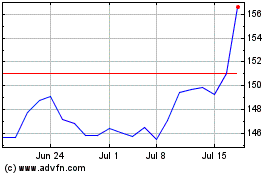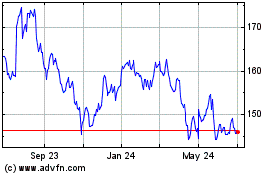Johnson & Johnson Ordered to Pay $572 Million in Oklahoma Opioid Case
August 26 2019 - 4:37PM
Dow Jones News
By Sara Randazzo and Jared S. Hopkins
Johnson & Johnson must pay $572 million for contributing to
an opioid-addiction crisis in Oklahoma, a judge there ruled Monday
in a closely watched trial.
The verdict comes in the first case to go to trial of more than
2,000 brought by state and local municipalities nationwide seeking
to hold the pharmaceutical industry accountable for widespread
opioid abuse.
In siding with the Oklahoma attorney general, state court judge
Thad Balkman rejected Johnson & Johnson's arguments that it
lawfully marketed and sold its prescription painkillers and isn't
to blame for a public-health crisis in the state.
Johnson & Johnson said it would appeal the verdict.
Over the course of the seven-week trial, attorneys for Oklahoma
argued that Johnson & Johnson is liable not only for two opioid
drugs it sold -- the fentanyl patch Duragesic and tapentadol pill
Nucynta -- but also because it owned two companies that supplied
the active pharmaceutical ingredients and narcotic raw materials to
other drugmakers for their own opioid painkillers.
Attorney General Mike Hunter said the company's actions created
a "public nuisance" and asked the judge to award as much as $17
billion for the state to abate the costs of the crisis, through
spending on areas like addiction treatment and overdose-prevention
programs.
Oklahoma saw 4,653 residents die from unintentional
prescription-opioid overdoses from 2007 to 2017, Mr. Hunter said in
court. In some years, the state said in court filings, the number
of painkiller prescriptions dispensed eclipsed the number of state
residents.
Johnson & Johnson became the lone defendant after two other
companies named in the 2017 lawsuit settled in the run-up to trial.
OxyContin-maker Purdue Pharma LP and its owners, the Sackler
family, agreed to pay $270 million, much of it to fund an
opioid-addiction research center. Teva Pharmaceutical Industries
Ltd. agreed to an $85 million deal.
The state's case hinged entirely on public nuisance law,
traditionally used in property disputes but increasingly becoming a
tool state attorneys general are using in cases against private
industries.
Johnson & Johnson argued during the trial that its drugs
accounted for a fraction of those taken in Oklahoma and that an
influx of illegal heroin and fentanyl were the real culprits in
overdose deaths.
Analysts closely followed the Oklahoma trial for signs of what
might happen in the broader opioid litigation. Attention will next
turn to Cleveland, where two counties are slated to go to trial in
October against an array of drugmakers and distributors. That trial
is serving as a bellwether for hundreds of others brought by cities
and counties that have been consolidated in federal court in Ohio
before U.S. District Judge Dan Polster.
The verdict could put pressure on settlement talks in the rest
of the opioid cases. Judge Polster has pushed the parties to settle
while allowing the October case to head to trial. Complicating
settlement talks is tension between state attorneys general, which
want to maximize recoveries from cases they have filed in state
courts, and the many cities and counties pressing cases in federal
court.
Johnson & Johnson is a relatively smaller player in the
opioid-painkiller market. From 2006 to 2012, its products
represented 8% of the market for fentanyl patches and pouches
bought by U.S. pharmacies, according to a Wall Street Journal
analysis of Drug Enforcement Administration data. The company
represented around one-quarter of 1% of the market for prescription
opioid pills in that period, the data shows. Johnson & Johnson
still makes Duragesic but sold its interests in Nucynta in 2015 and
exited the opioid-ingredients businesses by 2016.
Brad Beckworth, a Texas attorney hired to represent the Oklahoma
attorney general's office in the case, said the verdict shows that
the opioid crisis is about more than Purdue, which has drawn the
most attention for its role in marketing OxyContin for wide-ranging
pain. "This crisis didn't occur based on one person or one
company," Mr. Beckworth said.
As Johnson & Johnson continues to battle the opioid cases,
it also faces thousands of lawsuits alleging harms from its
signature baby powder, pelvic mesh and hip devices as well as a
handful of pharmaceutical products.
--Joseph Walker contributed to this article.
Write to Sara Randazzo at sara.randazzo@wsj.com
(END) Dow Jones Newswires
August 26, 2019 16:22 ET (20:22 GMT)
Copyright (c) 2019 Dow Jones & Company, Inc.
Johnson and Johnson (NYSE:JNJ)
Historical Stock Chart
From Mar 2024 to Apr 2024

Johnson and Johnson (NYSE:JNJ)
Historical Stock Chart
From Apr 2023 to Apr 2024
